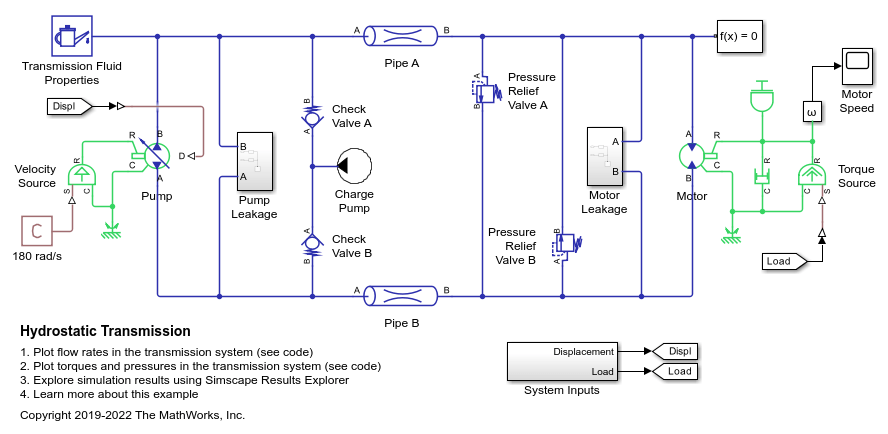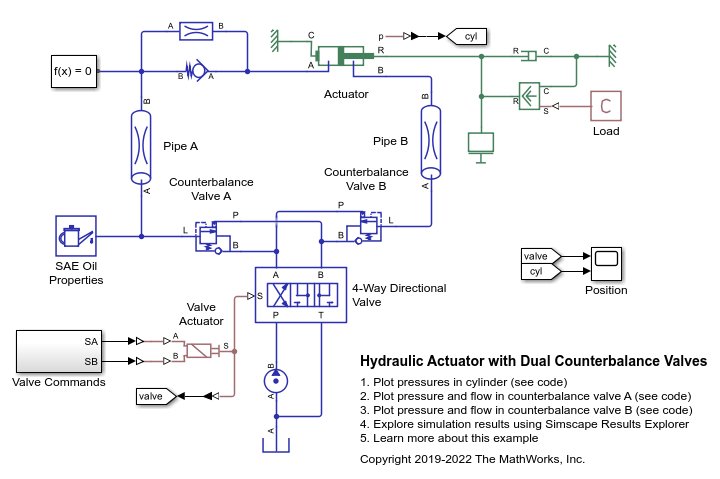Check Valve (IL)
Check valve in an isothermal liquid system
Libraries:
Simscape /
Fluids /
Isothermal Liquid /
Valves & Orifices /
Directional Control Valves
Description
The Check Valve (IL) block represents a check valve with free flow from port A to port B and restricted flow from port B to port A. When the pressure at port A or the pressure differential meets or exceeds the set pressure threshold, the valve begins to open.
Opening Parameterization
When Opening parameterization is set to Linear -
Area vs. pressure, the valve open area is linearly related to the
opening pressure differential.
There are two options for valve control:
When Opening pressure differential is set to
Pressure differential, the control pressure is the pressure differential between ports A and B. The valve begins to open when Pcontrol meets or exceeds the Cracking pressure differential.When Opening pressure differential is set to
Pressure at port A, the control pressure is the pressure difference between port A and atmospheric pressure. When Pcontrol meets or exceeds the Cracking pressure (gauge), the valve begins to open.
The linear parameterization of the valve area is
where the normalized pressure, , is
When the valve is in a near-open or near-closed position in the linear parameterization, you can maintain numerical robustness in your simulation by adjusting the Smoothing factor parameter. If the Smoothing factor parameter is nonzero, the block smoothly saturates the control pressure between pcracking and pmax. For more information, see Numerical Smoothing.
When you set Opening parameterization to
Tabulated data - Volumetric flow rate vs.
pressure, Avalve is
the linearly interpolated value of the Opening area vector
parameter versus Pressure differential vector parameter
curve for a simulated pressure differential.
Mass is conserved through the valve:
The mass flow rate through the valve is calculated as:
where:
Cd is the Discharge coefficient.
Avalve is the instantaneous valve open area.
Aport is the Cross-sectional area at ports A and B.
is the average fluid density.
Δp is the valve pressure difference pA – pB.
The critical pressure difference, Δpcrit, is the pressure differential associated with the Critical Reynolds number, Recrit, the flow regime transition point between laminar and turbulent flow:
Pressure loss describes the reduction of pressure in the valve due to a decrease in area. PRloss is calculated as:
Pressure recovery describes the positive pressure change in the valve due to an increase in area. If you do not want to capture this increase in pressure, clear the Pressure recovery check box. In this case, PRloss is 1.
Tabulated Volumetric Flow Rate Parameterization
When Opening parameterization is set to
Tabulated data - Volumetric flow rate vs. pressure,
the valve opens according to the user-provided tabulated data of volumetric flow
rate and pressure differential between ports A and
B.
The mass flow rate is
where:
is the average fluid density.
where Cd is the discharge coefficient, Recrit is the critical Reynolds number, and ν is the kinematic viscosity. In this parameterization, Cd and Recrit are fixed at
0.64and150, respectively.
When the block operates in the limits of the tabulated data,
where:
ΔpTLU is the Pressure drop vector parameter.
where TLU is the Volumetric flow rate vector parameter.
When the simulation pressure falls below the first element of the Pressure drop
vector parameter,
K=KLeak ,
where TLU(1) is the first element of the Volumetric flow rate vector parameter.
When the simulation pressure rises above the last element of the Pressure drop
vector parameter,
K=KMax,
where TLU(end) is the last element of the Volumetric flow rate vector parameter.
Opening Dynamics
The linear parameterization supports valve opening and closing dynamics. If opening dynamics are modeled, a lag is introduced to the flow response to the modeled control pressure. pcontrol becomes the dynamic control pressure, pdyn; otherwise, pcontrol is the steady-state pressure. The instantaneous change in dynamic control pressure is calculated based on the Opening time constant, τ:
By default, the block clears the Opening dynamics check box.
Faults
To model a fault, in the Faults section, click the Add fault hyperlink next to the fault that you want to model. Use the fault parameters to specify the fault properties. For more information about fault modeling, see Introduction to Simscape Faults.
The Opening area when faulted parameter has three options:
ClosedOpenMaintain at last value
After the fault triggers, the valve remains at the faulted area for the rest of the simulation.
In the linear parameterization, the fault options are defined by the valve area:
Closed— The valve area freezes at the Leakage area.Open— The valve area freezes at the Maximum opening area.Maintain at last value— The valve freezes at the open area when the trigger occurs.
In the tabulated parameterization, the fault options are defined by the mass flow rate through the valve:
Closed— The valve freezes at the mass flow rate associated with the first elements of the Volumetric flow rate vector and the Pressure drop vectorOpen— The valve freezes at the mass flow rate associated with the last elements of the Volumetric flow rate vector and the Pressure drop vectorMaintain at last value— The valve freezes at the mass flow rate and pressure differential when the trigger occurs
where
Generate Digital Data Sheet
Since R2025a
Generate a digital data sheet that includes performance data and pressure drop vs. volumetric flow rate curves for the Check Valve (IL) block by using the Generate datasheet hyperlink in the Description tab of the block dialog box. The datasheet script imports the parameters from the Check Valve (IL) block that you select in the model. You can use the characteristic curves to help evaluate the cracking pressure and the leakage flow for the selected Check Valve (IL) block. To open the live script:
Double-click the block to open the Block Parameters dialog box.
Open the Description tab.
Click the Generate datasheet hyperlink.
Click a Check Valve (IL) block in the model.
To generate the data sheet, in the live script, click the Generate datasheet button.
Predefined Parameterization
You can populate the block with pre-parameterized manufacturing data, which allows you to model a specific supplier component.
To load a predefined parameterization:
In the block dialog box, next to Selected part, click the "<click to select>" hyperlink next to Selected part in the block dialog box settings.
The Block Parameterization Manager window opens. Select a part from the menu and click Apply all. You can narrow the choices using the Manufacturer drop down menu.
You can close the Block Parameterization Manager menu. The block now has the parameterization that you specified.
You can compare current parameter settings with a specific supplier component in the Block Parameterization Manager window by selecting a part and viewing the data in the Compare selected part with block section.
Note
Predefined block parameterizations use available data sources to supply parameter values. The block substitutes engineering judgment and simplifying assumptions for missing data. As a result, expect some deviation between simulated and actual physical behavior. To ensure accuracy, validate the simulated behavior against experimental data and refine your component models as necessary.
To learn more, see List of Pre-Parameterized Components.


